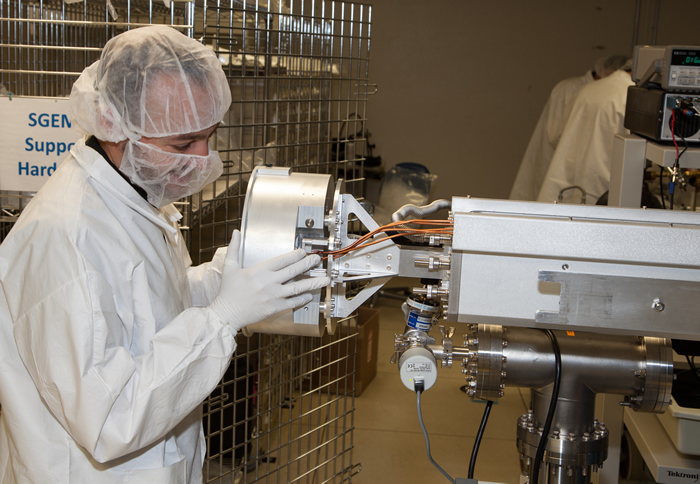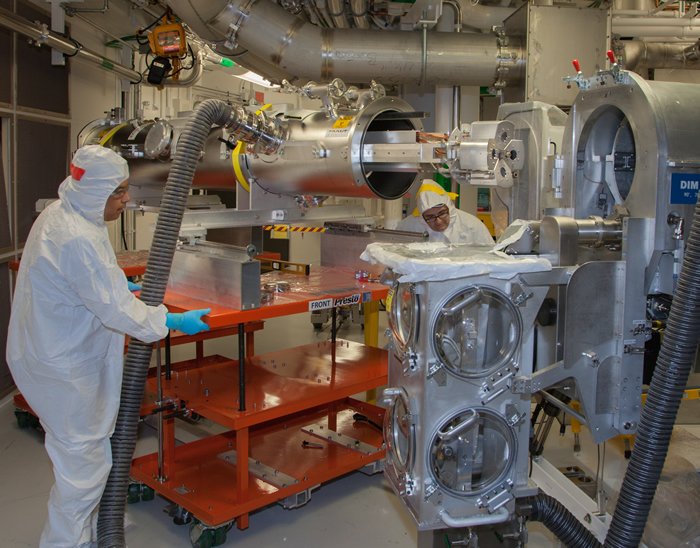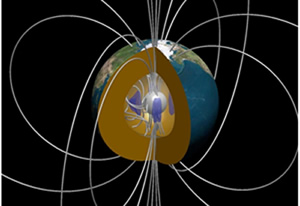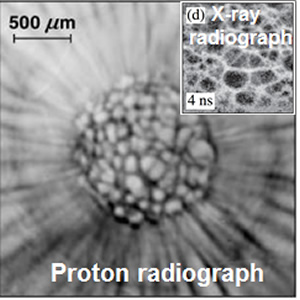Experimental Highlights - 2015
January
Nine Discovery Science Experiments Selected
NIF Experiments Help Validate Electromagnetic Pulse Codes
An important element of NIF’s National Security Applications mission is helping validate simulation codes designed to determine the effects of system-generated electromagnetic pulses (SGEMP) on various materials. Recently the NIF Team conducted three experiments for the SGEMP campaign, which is led by Sandia National Laboratories (SNL) and the UK’s Atomic Weapons Establishment (AWE).
The experiments were a continuation of the first SGEMP campaign performed last year. In those shots, the NIF laser created 7-keV (thousand-electron-volt) x-ray sources that drove electromagnetic current pulses similar to those generated at Sandia’s Z pulsed power facility in Albuquerque, New Mexico. About 500 kilojoules of ultraviolet laser energy produced the x-ray sources that created electromagnetic responses in various test objects mounted on two NIF diagnostic instrument manipulators (DIMs). Some of the test objects shared the target chamber vacuum, while others were filled with gas.
 Configuration of the two diagnostic instrument manipulators for the first SGEMP experiments, showing the test objects mounted on the equatorial DIMs being driven by the x-ray emission from the target.
Configuration of the two diagnostic instrument manipulators for the first SGEMP experiments, showing the test objects mounted on the equatorial DIMs being driven by the x-ray emission from the target. Five separate experiments contained in the SGEMP diagnostics cassettes spanned a range of conditions important to code validation. Local x-ray environments were diagnosed by calorimeters built into the cassettes, and NIF facility diagnostics provided additional details about the x-ray output from the laser-driven target. The SGEMP team staged a large amount of diagnostic and data acquisition equipment in the Target Bay for the tests. Excellent SGEMP data were recorded in both experiments, and the gas-fill system and in-situ calorimeters performed excellently. Small changes in the diagnostics between the first and second shots greatly improved facility diagnostic data quality.
 A member of the SGEMP Team installs a sample cassette on the SGEMP diagnostic system for deployment in a diagnostic instrument manipulator. These experiments use the powerful x-ray pulse generated in a custom-designed x-ray source target to create EMP effects in test objects.
A member of the SGEMP Team installs a sample cassette on the SGEMP diagnostic system for deployment in a diagnostic instrument manipulator. These experiments use the powerful x-ray pulse generated in a custom-designed x-ray source target to create EMP effects in test objects. The recent SEGEMP campaign used new x-ray sources at higher photon energies to get data from a unique x-ray environment. Experience gained in the first campaign enabled the team to optimize set-up of diagnostic and data acquisition systems as well as transactions between the shots. The x-ray sources for the recent tests included the 7-keV source as well as a 13-keV x-ray source created by a plasma formed from a krypton gas target with a unique x-ray spectrum to drive test-article effects. Both the 7-keV and 13-keV x-ray sources were developed and qualified in a series of dedicated shots in previous years. Two upcoming SGEMP shots using stainless steel instead of krypton gas will have 50 percent more laser power and significantly enhanced x-ray flux compared to the earlier shots.
 NIF target area operators load the SGEMP four-cassette diagnostic in a diagnostic instrument manipulator.
NIF target area operators load the SGEMP four-cassette diagnostic in a diagnostic instrument manipulator. “The known output from the x-ray sources allows SGEMP modelers and designers to develop precise experiments to isolate the physical phenomena of interest to their code validation program,” said LLNL Program Manager Kevin Fournier. “The team is looking ahead to the next set of trials this year that will use the 13-keV source again, but potentially with more than one megajoule of laser drive energy, as well as a new x-ray source with even higher x-ray energies.”
Along with researchers from AWE, members of the SGEMP Team include co-team leader Tim Flanagan of SNL; Program Manager Kevin Fournier of LLNL; Tom Zarick, Randall Romero, and Kate Blesener of SNL; and Marty Yeoman, Charles Brown, Fred Holdener, Steve Compton, Klaus Widmann, and Mark May of LLNL.
Nine Discovery Science Experiments Selected
Nine new NIF Discovery Science experiments have been awarded NIF shot time beginning in October of 2015. The experiments, selected from among 42 proposals submitted last summer, range from hydrodynamics to materials and planetary science, nuclear science and nuclear astrophysics, and plasma astrophysics.
NIF received 51 initial expressions of interest from national and international scientists from the academic, national laboratory, and private sectors. The 42 full proposals were reviewed by a Technical Review Committee (TRC) which met at the Laboratory Nov. 10-12. The TRC advised NIF on the relative scientific merit of the proposals.
“We anticipate 18 NIF days will be allocated to Discovery Science in Fiscal Year 2016 and similar yearly allocations going forward,” said Bruce Remington, program leader for NIF Discovery Science. “Each new experiment will receive about three days of facility time. Typically, one to three shots can be executed per shot day, depending on shot complexity.”
 Illustration of a planetary magnetosphere (Credit: Julian Aubert)
Illustration of a planetary magnetosphere (Credit: Julian Aubert) Remington said the TRC will meet for a status update in April, after which another call for proposals will be issued. “Calls will be issued annually,” he said. “We anticipate about six proposals will be accepted per call annually. Scheduling of the FY16 experiments will begin in the spring as part of the normal NIF scheduling process.”
Among the selected experiments are several which will subject materials to intense pressures, such as those in the interiors of stars and giant planets, that only NIF is capable of producing. The experiments will enable researchers to quantify the change in the materials’ crystal structure as a function of applied pressure, providing clues to planet formation and structure as well as to the exotic behavior of materials at high densities (see Experimental Highlights, December 2014). Other experiments will examine collisionless shocks and the generation and amplification of planetary and astrophysical magnetic fields (see Science & Technology, July 2014); NIF is the only facility that can create the proper plasma conditions to generate fully formed astrophysical collisionless shocks and strong magnetic field amplification by a turbulent dynamo process. Stellar and Big Bang nucleosynthesis, the evolution of hydrodynamic instabilities, and the development of a long-duration planar direct-drive NIF platform also will be studied.
The TRC members—highly respected scientists from across the different fields of science relevant to the review—are committee Chair Chris McKee of UC Berkeley; Vice Chair John Sarrao of Los Alamos National Laboratory (LANL); Richard Firestone of Lawrence Berkeley National Laboratory; Nat Fisch of Princeton University; Denise Hinkel and Mordy Rosen of LLNL; Siegfried Glenzer of SLAC National Accelerator Laboratory; Riccardo Betti of the University of Rochester; Ray Leeper of LANL; and Choong-Shik Yoo of Washington State University.
The selected proposals are:
Equation of State/Materials Science
- Release and metastability of dynamically compressed carbon: Justin Wark and Matt Suggit, Univ. Oxford, UK; Andrew Higginbotham, Univ. York, UK; Amy Jenei and Jon Eggert, LLNL
- The iron melting curve and magnetospheres of habitable super Earths: Russ Hemley, Carnegie Institution of Washington (CIW); Lars Stixrude, Univ. College London (UCL), UK; Ron Cohen, CIW, UCL; Sarah Stewart, UC Davis; Rick Kraus, Dayne Fratanduano and Jon Eggert, LLNL
- Pressure ionization at extreme densities: Paul Neumayer, GSI Darmstadt, Germany; Roger Falcone and Dominik Kraus, UC Berkeley; R. Redmer, Univ. Rostock, Germany; D. Gericke, Univ. Warwick, UK; a member of the Atomic Weapons Establishment, UK; Tilo Döppner and Benjamin Bachmann, LLNL
Hydrodynamics
- Asymptotic self-similar evolution of RT and RM instabilities: Dov Shvarts and Yoni Elbaz, Nuclear Research Center Negev (NRCN), Israel; M. Fraenkel and A. Zigler, Soreq Nuclear Research Center, Israel; Carolyn Kuranz and Paul Drake, Univ. Mich.; Alex Casner, Alternative Energies and Atomic Energy Commission (CEA), France; Channing Huntington, Tammy Ma, Steve MacLaren, and Kumar Raman, LLNL
- Long duration, planar, direct-drive platform development: Alex Casner, CEA; Igor Igumenshchev, Laboratory for Laser Energetics (LLE), Univ. Rochester; Paul Drake, Univ. Mich.; T. Plewa, Florida State Univ.; L. Gao, Princeton Plasma Physics Laboratory; X. Ribeyre, Univ. Bordeaux, France; D. Shvarts and G. Malamud, NRCN and Ben-Gurion Univ., Israel; Vladimir Smalyuk and David Martinez, LLNL
 Radiographs from a direct-drive hydrodynamics experiment
Radiographs from a direct-drive hydrodynamics experiment Plasma Astrophysics Physics
- Generation of collisionless shocks and magnetic fields: Youichi Sakawa and H. Takabe, Osaka Univ., Japan; T. Morita, Kyushu Univ., Japan; Gianluca Gregori, Oxford; Dustin Froula, LLE; Rich Petrasso, Massachusetts Institute of Technology (MIT); A. Spitkovsky, Princeton Univ.; M. Koenig, Ecole Polytechnique, France; D. Lamb, Univ. Chicago; Frederico Fiuza, Kavli Institute, Stanford Univ.; Hye-Sook Park, Steve Ross, and Dmitri Ryutov, LLNL
- Primordial magnetogenesis and turbulent amplification: Gianluca Gregori, Oxford; D. Lamb, Univ. Chicago; Y. Sakawa, Osaka Univ.; Dustin Froula, LLE; M. Koenig, Ecole Polytechnique; Alex Casner, CEA; Rich Petrasso, MIT; F. Miniati, Federal Institute of Technology, Switzerland; B. Reville, Queen’s Univ., UK; D. Ryu, Ulsan National Institute of Science and Technology, Korea; A. Spitkovsky, Princeton; Hye-Sook Park and Steve Ross, LLNL
Nuclear Physics
- Stellar and Big Bang nucleosynthesis: Maria Gatu-Johnson, MIT; Carl Brune, Ohio Univ.; Hans Herrmann, LANL; Andrew Bacher, Indiana Univ.; Dan Casey and Dan Sayre, LLNL
- Charged particle stopping powers in dense degenerate plasmas: Alex Zylstra, Chikang Li, and Johan Frenje, MIT; Paul Grabowski, UC Irvine; Ryan Rygg, Jesse Pino, and Frank Graziani, LLNL




